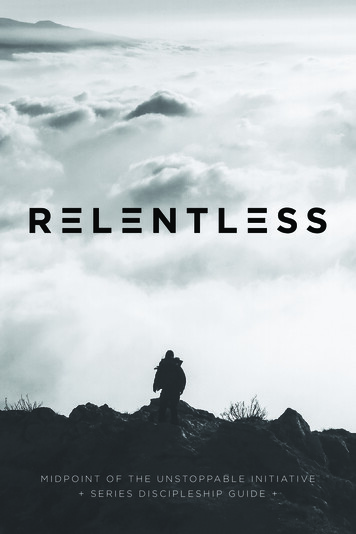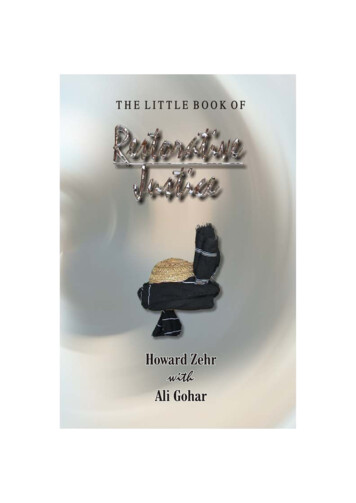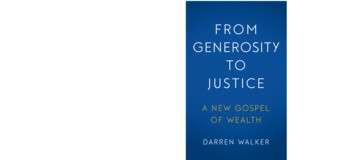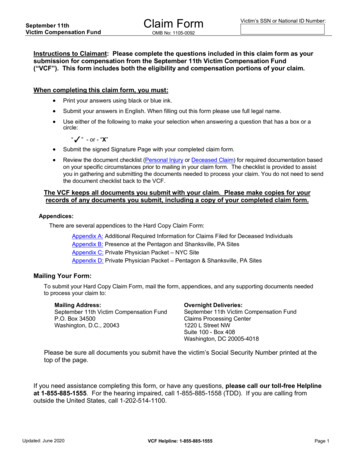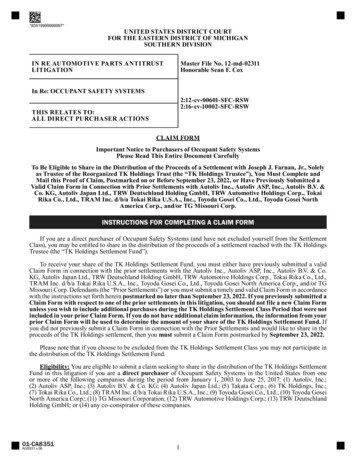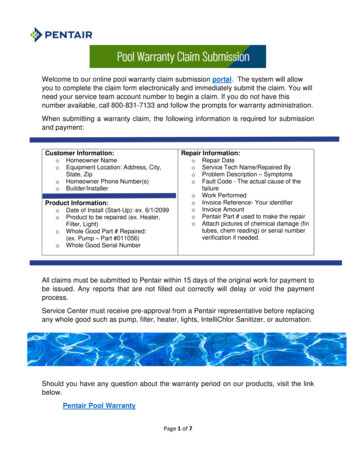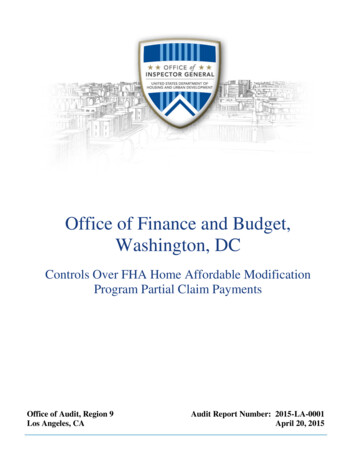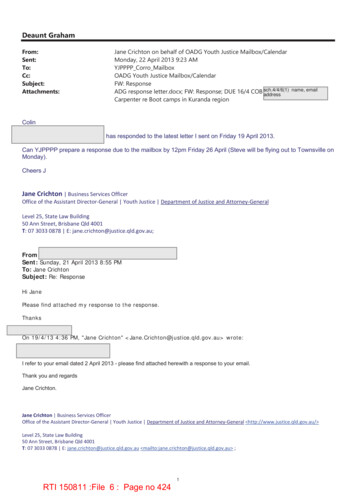
Transcription
JUSTICE BEFORE GENEROSITY: CREDITORS’CLAIM TO ASSETS OF A REVOCABLE TRUSTAFTER THE DEATH OF THE SETTLORLauren Ashley Gribble*I.II.III.IV.Introduction . 384Development of Ohio Law on Creditors’ Access toRevocable Trust Funds . 386A. Revocable Trusts . 386B. Precedent on Creditor Access to Revocable Trusts . 386C. Statutory Law on Creditor Access to RevocableTrusts. 389Should Creditors Be Able to Access the Assets ofRevocable Trusts after the Death of the Settlor underOhio Law . 392A. The Third Appellate District . 392B. The Sixth Appellate District . 394C. Resolving the Conflict . 396Creditors Should Be Able to Access the Assets of aRevocable Trust after the Death of the Settlor . 397A. Permitting Creditors Access to the Assets of aRevocable Trust is in Keeping with the Principlesof Ohio Law and Public Policy . 397B. Permitting Creditors Access to the Assets of aRevocable Trust is in Keeping with PersuasiveAuthorities. 3981. The Uniform Trust Code . 3992. State Court Decisions . 4003. Statutory Law . 406C. Permitting Creditors Access to the Assets of a* J.D. Candidate, The University of Akron School of Law, May 2015. Production Editor, The AkronLaw Review, 2014-2015. Member, Akron Law Trial Team, 2014-2015. Assistant Editor, The AkronLaw Review, 2013-2014. Fellow, Academic Success Program, 2013-2014. B.A., summa cum laude,Hillsdale College, May 2010. Sincere thanks to Professor Alan Newman for his assistance with thisarticle.383
384V.AKRON LAW REVIEW[48:383Revocable Trust is a Question of StatutoryAmendment for the Legislature . 412D. Potential Pitfalls Can Be Avoided with CarefulDrafting . 414Conclusion . 417I. INTRODUCTIONThe use of will substitutes, in general, and revocable trusts, inparticular, are on the rise. 1 Revocable trusts permit settlors to make intervivos asset transfers that provide for the disposition of those assets attheir death outside the probate system yet also enable them to retainultimate control of those assets during life through the power ofrevocation. 2 The trend toward probate avoidance, however, has left onegroup scrambling to find its place: creditors. 3 Traditionally, discharginga decedent’s debts was an essential function of the probate process, andcreditor protection, one of its primary goals. 4 As Blackstone explainedmore than two hundred years ago, “[I]t is [the executor’s] business firstof all to see whether there is a sufficient fund left to pay the debts of thetestator: the rule of equity being, that a man must be just before he ispermitted to be generous.” 5 Creditor protection, however, has not beenbuilt into the law of trusts as into the law of succession, although states1. John H. Langbein, The Nonprobate Revolution and the Future of the Law of Succession,97 HARV. L. REV. 1108, 1109-15 (1984) (noting that the use of will substitutes has become commonin the United States and outlining four primary types); David M. English, The Uniform Trust Code(2000): Significant Provisions and Policy Issues, 67 MO. L. REV. 143, 186 (2002) (noting thatrevocable trusts are the most common trusts in the United States and are used primarily as willsubstitutes).2. Alan Newman, Revocable Trusts and the Law of Wills: An Imperfect Fit, 43 REAL PROP.TR. & EST. L.J. 523, 524 (2008) (describing the operation of revocable trusts).3. Nathaniel W. Schwickerath, Note, Public Policy and the Probate Pariah: Confusion inthe Law of Will Substitutes, 48 DRAKE L. REV. 769, 796-97 (2000) (noting the trend toward probateavoidance).4. Langbein, supra note 1, at 1117 (discussing the three essential functions of probate: “(1)making property owned at death marketable again (title-clearing); (2) paying off the decedent’sdebts (creditor protection); and (3) implementing the decedent’s donative intent respecting theproperty that remains once the claims of creditors have been discharged (distribution)”);Schwickerath, supra note 3, at 770 (noting that the law of succession has long valued creditorprotection); see also Richard J. Ruebel, Planning for the Impact of Creditors’ Claims Against aClient’s Nonprobate Property, 15 EST. PLAN. 38, 38 (1988) (noting that handling claims against adecedent’s probate estate is now a matter of routine).5. WILLIAM BLACKSTONE, BLACKSTONE’S COMMENTARIES ABRIDGED 283 (William C.Sprague ed., 9th ed. 1915) (1892).
2015]JUSTICE BEFORE GENEROSITY[48:385have recently begun to address some of the creditors’ rights issuesarising from the use of revocable trusts. 6Ohio is among them. The Ohio legislature recently passed the OhioTrust Code, which primarily codified existing trust law. 7 In keeping withthe operation of revocable trusts and the principle that settlors should notbe able to use such trusts to avoid creditors, it provides that creditorsmay claim the assets of a revocable trust during the lifetime of thesettlor. 8 It is, however, silent as to creditors’ ability to access trust fundsafter the settlor’s death. 9 Two Ohio appellate courts have discussed thestatute, only to arrive at different conclusions regarding its operation andsignificance in light of case precedent. 10This Article will argue that the Ohio legislature should amend thestatute to permit creditors access to the assets of a revocable trust tosatisfy the settlor’s debts upon his death under certain limitedcircumstances. Part II will discuss pertinent background, including thenature and use of the revocable trust, creditors’ access to trust funds inthe past, and the development of Ohio’s statutory law on the subject.Part III will set forth the conflict between the Ohio appellate courts inmore detail, framing the relevant issues. Part IV will consider thearguments in favor of permitting creditors access to revocable trust fundsafter the settlor’s death, while also proposing a method for so doing byshowing the following: first, it is in keeping with the principles of Ohiolaw and public policy; second, it is in keeping with persuasive authority;third, it is a question of statutory amendment for the legislature; fourth,potential pitfalls can be avoided with careful drafting.6. Ruebel, supra note 4, at 39 (discussing the nature of revocable trusts and recently adoptedstatutes addressing creditors’ claims on their assets).7. Alan Newman, The Uniform Trust Code: An Analysis of Ohio’s Version, 34 OHIO N.U. L.REV. 135, 136 (2008). The Ohio Trust Code became effective January 1, 2007. Id.8. OHIO REV. CODE ANN. § 5805.06(A) (West, Westlaw through the 130th GA (20132014)) (“Whether or not the terms of the trust contain a spendthrift provision, all of the followingapply: (1) During the lifetime of the settlor, the property of a revocable trust is subject to claims ofthe settlor’s creditors.”).9. Id.10. Sowers v. Luginbill, 175 Ohio App. 3d 745, 889 N.E.2d 172, 2008-Ohio-1486, at ¶¶ 13,27-29 (concluding that O.R.C. § 5805.06(A)(1) does not permit subsequent creditors to file claimsto a settlor’s revocable trust and defining subsequent creditor as a person who files his claim afterthe settlor’s death); Watterson v. Burnard, 986 N.E.2d 604, 608-11 (Ohio. Ct. App. 2013)(concluding that O.R.C. § 5805.06(A)(1) permits all claims filed before the settlor’s death, even ifthe settlor dies while the claim is pending, regardless of whether the claimant is a subsequentcreditor and declining to determine whether the claim must be filed before the settlor’s death).
386AKRON LAW REVIEW[48:383II. DEVELOPMENT OF OHIO LAW ON CREDITORS’ ACCESS TOREVOCABLE TRUST FUNDSA.Revocable TrustsA revocable trust is created when the settlor transfers assets into thetrust but reserves an equitable life interest 11 and retains the power ofrevocation and amendment. 12 With appropriate drafting, a revocabletrust “can replicate the incidents of a will.”13 The settlor typically namesremainder beneficiaries for whose benefit trust assets will be held or towhom trust assets will be distributed upon the settlor’s death. 14 Becausethe settlor, while living, can alter the terms of the trust, including itsbeneficiary designations, the trustee owes the remainder beneficiaries noduties until the trust becomes irrevocable upon the settlor’s death. 15 Theremainder beneficiaries of a revocable trust may not even be aware oftheir interests in the trust. 16 Thus, although remainder beneficiariestechnically receive a beneficiary interest in trust property, this interest isincreasingly treated like an expectancy while the settlor is still living. 17In sum, the revocable trust functions like a will but manages to avoid the“cumbersome, time-consuming, and expensive” process of estateadministration. 18 It is unsurprising that revocable trusts have becomepopular estate planning devices in recent years. 19B.Precedent on Creditor Access to Revocable TrustsCreditor avoidance has been another, though perhaps unintended,advantage of employing a revocable trust as a will substitute. 20Traditionally under Ohio law, after the death of a settlor of a revocabletrust, creditors of the settlor could not access assets placed in trust absent11. A trust beneficiary does not hold legal title to trust assets but maintains an interestenforceable in equity. See BLACK’S LAW DICTIONARY 885 (9th ed. 2009).12. Newman, supra note 2, at 524; Langbein, supra note 1, at 1113.13. Langbein, supra note 1, at 1113.14. Newman, supra note 2, at 524.15. Id. at 532-33.16. Id. at 532.17. Id. at 531-32.18. Id. at 524.19. English, supra note 1, at 186 (noting that “the extensive use of revocable trusts is a recentphenomenon”).20. Ruebel, supra note 4, at 41 (“Revocable trusts, of course, are not usually created to defeatthe claims of creditors, although they lend themselves well to that purpose.”). This is furtherevidenced by scholarship recommending trust-drafting techniques to maximize asset protectionfrom creditors. See Dennis M. Sandoval, Drafting Trusts for Maximum Asset Protection fromCreditors, 17 NAELA, no. 5, 2004, at 10.
2015]JUSTICE BEFORE GENEROSITY[48:387intent to defraud. 21 As early as 1853, the Ohio Supreme Court addressedasset transfers intended to defraud creditors in Crumbaugh v. Kugler. 22 Itcautioned that “[w]herever a person, largely indebted, gives away a largeamount of his property, without amply providing for the payment of hisdebts, a suspicion of fraud will generally attach to the transaction.” 23 Itconcluded that such transfers were invalid with respect to previouscreditors but valid with respect to subsequent creditors, absent intent todefraud. 24 Ultimately, it held that no intent to defraud was present inCrumbaugh, and the transfer did not prejudice the subsequentcreditors. 25In 1880, the United States Supreme Court expounded on theimplication of fraud arising from the power of revocation in Jones v.Clifton. 26 In that case, Clifton transferred land estates to his wife via adeed in which he reserved the power of revocation and appointment toother uses. 27 Subsequently, he filed for bankruptcy. 28 Jones, the assigneein the bankruptcy, sought to include this property among his assets,arguing that Clifton intended to defraud his future creditors whileretaining control and enjoyment of the property. 29 The Supreme Courtheld that reserving the power of revocation and appointment to otheruses did not invalidate the transfer or demonstrate intent to defraud:The insertion of the power of revocation and new appointment. . .tendsto show the contrary. Should he revoke the settlements, the propertywould revert to him, and, of course, be liable for his debts; and shouldhe exercise the power of appointment for the benefit of others, the es30tate appointed would be liable in equity for his debts.Thus, the Court did not consider the power of revocation to be a propertyinterest against which creditors could levy a claim.Finally, in 1939, the Ohio Supreme Court established the followingrule respecting revocable trusts in Schofield v. Cleveland Trust Co.:Where the owner of property has conveyed it to another under a trust21. See Schofield v. Cleveland Trust Co., 21 N.E.2d 119 (Ohio 1939) (holding that, absentintent to defraud, a revocable trust is not voidable by subsequent creditors).22. Crumbaugh v. Kugler, 2 Ohio St. 373, 376-78 (1853) (discussing intent to defraudcreditors through a donative transfer).23. Id. at 376.24. Id. at 373.25. Id. at 379.26. See Jones v. Clifton, 101 U.S. 225 (1880).27. Id. at 226.28. Id. at 227.29. Id.30. Id. at 230.
388AKRON LAW REVIEW[48:383instrument, containing a power of revocation, to hold such property forthe benefit and enjoyment of the settlor during his life and at his deathto distribute the same among designated beneficiaries, such trust, lack31ing fraud, is not voidable by subsequent creditors.The court did not explicitly define “subsequent creditor,” a term liftedfrom Crumbaugh v. Kugler. 32 It cited Crumbaugh in explaining therationale for the rule. 33 Future creditors provide credit on the basis of thedebtor’s present assets, not on the basis of his or her past assets. 34 Thisreiterates that the settlor of a revocable trust does not retain a propertyinterest in its assets. Thus, creditors whose claims arise after its creationcannot access its funds.This understanding is supported by the facts in Schofield. Whilecompletely solvent, Ehert created and funded a revocable trust, reservingthe rights to receive any net income from the trust, occupy any realestate included in the trust, and approve or deny sale of propertyconnected with the trust. 35 Upon his death, the trustee was to distributethe property to Ehert’s wife and daughter. 36 Subsequently, Ehertdefaulted on rental payments to the plaintiff. 37 Shortly thereafter, he diedintestate. 38 The court held that the plaintiff had no claim to the trustfunds, because the trust was created before Ehert incurred the debt. 39 Itrejected the persuasive authorities cited by the plaintiff, noting that thosedecisions were rendered under statutes which explicitly permittedcreditors to claim trust assets. 40 A settlor who reserved the power ofrevocation or established the trust for personal use and enjoyment was“deemed the absolute owner of the estate conveyed as regards (to) the31. Schofield v. Cleveland Trust Co., 21 N.E.2d 119 (Ohio 1939). This remains the ruleunder Ohio law today. Newman, supra note 7, at 175.32. See Crumbaugh v. Kugler, 2 Ohio St. 373, 378-79 (1853) (distinguishing between priorcreditors and subsequent creditors); Schofield, 21 N.E.2d at 121 (noting that the rule in Ohio hasbeen that subsequent creditors may not set aside a transfer made by one while solvent). The Ohioappellate districts have disagreed regarding the meaning and significance of “subsequent creditor”in Schofield. Compare Sowers v. Luginbill, 175 Ohio App. 3d 745, 889 N.E.2d 172, 2008-Ohio1486, at ¶ 13 (holding that a subsequent creditor is one who files his claim after the settlor’s death),with Watterson v. Burnard, 986 N.E.2d 604, 609 (Ohio Ct. App. 2013) (holding that a subsequentcreditor is one whose claim arises after creation of the trust, regardless of when he files his claim).This disagreement will be discussed in Part III.33. See Schofield, 21 N.E.2d at 122.34. Id.35. Id. at 120.36. Id. at 121.37. Id.38. Id.39. Id. at 121-23.40. Id. at 123.
2015]JUSTICE BEFORE GENEROSITY[48:389right of creditors” by such statutes. 41 They treated a revocable trust as aproperty interest held by the settlor even after death.42 The courtemphasized that Ohio law does not permit such claims, absent fraud.43Thus, although present creditors may have a claim to trust assets,creating a revocable trust can protect assets from future creditors. Therule announced in Schofield placed the burden on creditors to ensure thatdebtors could repay regardless of whether they had income from, oraccess to, the assets of a revocable trust.C.Statutory Law on Creditor Access to Revocable TrustsThis burden, however, was complicated by Ohio statutory law,which appeared to afford creditors some protection. The Ohio legislaturepassed a law explicitly addressing creditors’ rights to revocable trustassets in 1921, eighteen years prior to Schofield, in an amendment tosection 8617 of the General Code. 44 It provided some protection forcreditors:All deeds of gifts and conveyance of real or personal property made intrust for the exclusive use of the person or persons making the sameshall be void and of no effect, but the creator of a trust may reserve tohimself any use or power, beneficial or in trust, which he might lawfully grant to another, including the power to alter, amend or revoke suchtrust, and such trust shall be valid as to all persons, except that anybeneficial interest reserved to such creator shall be subject to bereached by the creditors of such creator, and except that where the creator of such trust reserves to himself for his own benefit a power ofrevocation, a court of equity, at the suit of any creditor or creditors ofthe creator, may compel the exercise of such power of revocation soreserved, to the same extent and under the same conditions that such45creator could have exercised the same.This statute explicitly endorsed revocable trusts but created a causeof action for creditors against indebted settlors to reach the assets of suchtrusts. 46 It did not stipulate whether this cause of action was available to41. Id. at 122.42. Id. (noting that other jurisdictions permit creditors to claim trust assets even after thesettlor’s death).43. Id. (“[A]fter the settlor’s death, if the trust was in reality fraudulent as to creditors, aremedy would doubtless be available to the administrator or the creditors to subject the trustproperty to the satisfaction of the settlor’s indebtedness.”).44. See id. at 122.45. Id.46. See Cleveland Trust Co. v. White, 15 N.E.2d 627, 631 (Ohio 1938) (recognizing thatrevocable trusts were valid because of section 8617 of the General Code); see also Union Trust Co.v. Hawkins, 167 N.E. 389, 394-95 (Ohio 1929) (discussing the effect of the amendment to this
390AKRON LAW REVIEW[48:383subsequent creditors, and the plain language suggested no limitation tocreditors whose claims arose prior to trust creation. The plaintiff inSchofield was a subsequent creditor, but the court did not reach thequestion of whether this status would bar his claim under section 8617 ofthe General Code. 47 Instead, the court noted the statutory languageenabling creditors to compel exercise of the power of revocation “to thesame extent and under the same conditions” as the settlor could havedone. 48 The settlor’s power is personal: it ceases to exist upon his death,and the trust becomes irrevocable.49 If the settlor cannot revoke the trustafter his death, his creditors cannot either. The court concluded that thelegislature would have provided differently if it had intended to permitcreditors to revoke a trust after the settlor’s death. 50 The plaintiff failedto act while Ehert was living, and the statute was inapplicable to him forthat reason. 51 Thus, the court did not determine whether it wasinapplicable to him because he was a subsequent creditor.52 Followingthe court’s reasoning, it seems that, if the legislature had intended todistinguish the rights of prior creditors from those of subsequentcreditors, it would have done so explicitly. This suggests that the statuterecognized a present property interest in the assets of a revocable trust. Ifthe settlor retains a property interest in trust funds, creditors couldinclude that interest in determining how much credit to extend. 53Nevertheless, the Schofield court established that creditors must actduring the settlor’s lifetime to succeed in making a claim. 54 Thus, thesection which mentioned creditors).47. See Schofield, 21 N.E.2d at 122.48. See id.49. Id.; see also Goldstein v. United States, No. 1:91CV0969, 1992 WL 402944, at *3 (N.D.Ohio Sept. 2, 1992) (noting that a deceased settlor had no property rights in trust assets when theIRS issued a notice of assessment three years after his death because the trust became irrevocable atthat point).50. Schofield, 21 N.E.2d at 122.51. Id. at 123.52. In Individual Business Services v. Carmack, the Second Appellate District interpreted thesubsequent version of this statute, O.R.C. § 1335.01(A), as permitting subsequent creditors tocompel revocation of the trust. See Individual Bus. Servs. v. Carmack, No. 24085, 2011-Ohio-1824,¶ 62 (Ohio Ct. App. Apr. 15, 2011) (“Under the trust terms, Danies retained the power to revoke thetrust, and R.C. 1335.01(A) would have allowed IBS and CMC to compel her to revoke the trust andsubject the property in the trust to creditors’ claims. Accordingly, even if Danies did not haveexisting creditors when the trust was created in 1998, or when the Mad River Property was placed inthe trust, future creditors could compel Danies to revoke the trust and allow assets to be used to paythe creditors’ claims.”).53. See Isabelle V. Taylor, Comment, Creditor Rights and the Missing Link in the ArkansasTrust Code: Is Death Strong Enough “To Break the Chain?”, 65 ARK. L. REV. 433, 451 (2012)(discussing views on the nature of the interest passed to beneficiaries when a revocable trust iscreated and their implications for creditors).54. Schofield, 21 N.E.2d at 122.
2015]JUSTICE BEFORE GENEROSITY[48:391protection extended by the statute was limited, and the burden remainedon creditors to assert claims as quickly as possible to keep them frombeing barred by the settlor’s death.The provisions of section 8617 of the General Code were includedin Ohio Revised Code (“O.R.C.”) section 1335.01 when it was passed in1953. 55 It contained identical language and remained in effect untilJanuary 1, 2007, when it was repealed by House Bill 416. 56 House Bill416 included the new Ohio Trust Code, a modified version of theUniform Trust Code. 57 The Ohio Trust Code addressed “many issuesthat formerly were either not addressed by Ohio law or were addressedonly in difficult to find case law.” 58 Its primary function regardingcreditors’ claims against settlors of revocable trusts was to codifyexisting statutes and case law. 59 Thus, O.R.C. section 5805.06 provides,“Whether or not the terms of the trust contain a spendthrift provision . . .[d]uring the lifetime of the settlor, the property of a revocable trust issubject to the claims of the settlor’s creditors.” 60 It remains silent as tocreditors’ ability to access trust assets after the settlor’s death, notablyomitting section 505(a)(3) of the Uniform Trust Code. 61 Therefore, the55. Prestige Vacations, Inc. v. Kozak, 471 F. Supp. 410, 411 (N.D. Ohio. 1979) (quoting thelanguage of O.R.C. § 1335.01 and applying the Schofield court’s analysis of the “predecessorstatute”); OHIO REV. CODE ANN. § 1335.01 (West, Westlaw through the 130th GA (2013-2014))(noting it was enacted by House Bill 1 in 1953).56. See Prestige, 471 F. Supp. at 411 (quoting O.R.C. § 1335.01); OHIO REV. CODE ANN. §1335.01 (noting the statute’s repeal in 2007).57. Newman, supra note 7, at 136; see also English, supra note 1, at 144-52 (discussingcreation of the Uniform Trust Code). Regarding the Ohio Trust Code’s relation to the Uniform TrustCode, Prof. Newman explains, “Shortly after the National Conference of Commissioners onUniform State Laws approved the Uniform Trust Code (‘UTC’) in August of 2000, members of theEstate Planning, Trust, and Probate Law (‘EPTPL’) Section of the Ohio State Bar Association, andmembers of the Legal, Legislative, and Regulatory (‘LLR’) Committee of the Ohio BankersLeague, began studying it. In 2003, a joint committee of members of the EPTPL Section and theLLR Committee (the ‘Joint Committee’) was formed to continue that study. Over the next threeyears, the Joint Committee worked on a modified version of the UTC that resulted in the enactmentin 2006 of House Bill 416, which includes the new Ohio Trust Code (the ‘OTC,’ or the ‘Code’).”Newman, supra note 7, at 135-36.58. Newman, supra note 7, at 136.59. Id. at 172-73.60. OHIO REV. CODE ANN. § 5805.06(A)(1).61. Newman, supra note 7, at 175. See OHIO REV. CODE ANN. § 5805.06(A)(1). UniformTrust Code § 505(a)(3) provides that creditors may assert claims against revocable trust assets afterthe death of the settlor when his probate estate is insufficient to satisfy them: “Whether or not theterms of a trust contain a spendthrift provision . . . [a]fter the death of a settlor, and subject to thesettlor’s right to direct the source from which liabilities will be paid, the property of a trust that wasrevocable at the settlor’s death is subject to claims of the settlor’s creditors, costs of administrationof the settlor’s estate, the expenses of the settlor’s funeral and disposal of remains, and [statutoryallowances] to a surviving spouse and children to the extent the settlor’s probate estate is inadequateto satisfy those claims, costs, expenses, and [allowances].” UNIF. TRUST CODE § 505(a)(3) (West2013).
392AKRON LAW REVIEW[48:383rule announced in Schofield remains intact. 62III. SHOULD CREDITORS BE ABLE TO ACCESS THE ASSETS OFREVOCABLE TRUSTS AFTER THE DEATH OF THE SETTLOR UNDER OHIOLAWA.The Third Appellate DistrictThe Ohio Supreme Court has not had opportunity to examinesection 5805.06 of the Ohio Trust Code. Two appellate courts, however,have addressed it and have taken different positions regarding itsinterpretation and significance. In Sowers v. Luginbill, the ThirdAppellate District attempted to reconcile section 5805.06(A)(1) with theOhio Supreme Court’s holding in Schofield. 63 Gordon Sowers caused anautomobile accident, which injured Melanie Luginbill. 64 Luginbillsubsequently filed a negligence suit against him. 65 After the suit wasfiled, Sowers died unexpectedly. 66 John Sowers, Gordon’s brother, wasexecutor of his estate, and he filed an action for declaratory judgment,arguing that the assets of his brother’s revocable trust could not be usedto satisfy Luginbill’s personal injury claims. 67 The trial court ruled inLuginbill’s favor on the negligence claims and held that she couldsatisfy those claims from the trust assets. 68 Sowers appealed, but theappellate court ultimately affirmed the trial court. 69The Third Appellate District first defined “subsequent creditor” in amanner that reconciled it with the Schofield holding and the plainlanguage of the present statute. According to the appellate court, asubsequent creditor is one “whose claim comes into existence after agiven fact or transaction.” 70 The relevant fact or transaction to determinesubsequent creditor status is the death of the settlor. 71 The appellatecourt pointed out that the Schofield court emphasized that the plaintifffailed to file his claim before Ehert’s death even though his claim arose62. Newman, supra note 7, at 175.63. Sowers v. Luginbill, 175 Ohio App. 3d 745, 889 N.E.2d 172, 2008-Ohio-1486, at ¶¶ 12,17-29. See generally Michael A. Ogline, Sowers v. Luginbill: A Chink in the Schofield Armor?, 19OHIO PROB. L.J. 15 (2008) (analyzing the Sowers court’s approach to Schofield).64. Sowers, 2008-Ohio-1486 at ¶ 2.65. Id. at ¶ 3.66. Id. at ¶ 4.67. Id. at ¶¶ 4-5.68. Id. at ¶ 7.69. Id. at ¶ 46.70. Id. at ¶ 13.71. Id.
2015]JUSTICE BEFORE GENEROSITY[48:393during Ehert’s lifetime. 72 Thus, the statute was inapplicable to him. 73 Itdistinguished the present case from Schofield because Luginbill filed herclaim prior to Sowers’ death. 74 This characterization of subsequentcreditor status does not strictly fit within the definition offered by theSchofield court, as it does not depend on when the claim comes intoexistence but rather on when the claim is filed.75 It further ignores thediscussion in Schofield regarding the Crumbaugh precedent and the factthat Ehert was solvent when he created the trust.76 It does, however,succeed in clarifying the Schofield opinion in light of the present statuteand clearly bars all claims not filed before the settlor’s death. 77The Third Appellate District noted that the present statute promotescreditor protection. 78 First, it permits creditors to reach funds of anirrevocable trust to the degree that the settlor retains an interest inthem. 79 The court explained, “By providing protection for creditors ineither circumstance, it is evident that the legislature sought to providecomprehensive creditor protection.” 80 Second, the court cited theOfficial Comment to section 5805.06(A)(1) of the Uniform Trust Code,which also emphasized that the purpose of the section is creditorprotection. 81 Thus, the court rejected Sowers’ argument that thedefinitive event regarding creditor status was the creation and funding ofthe trust. 82 This would conflict with the legislature’s purpose ofcomprehensive creditor protection by unnecessarily limiting trust accessto creditors whose claims were filed before its creation or funding. 83Once again, this understanding depends on the date the claim was filedrather than the date on which the claim arose. Nevertheless, a bright linerule prevents the court from engaging in potentially complicated72. Id. at ¶ 16.73. Id.74. Id. at ¶ 17.75. See supra note 68 and accompanying text.76.
after the settlor's death.9 Two Ohio appellate courts have discussed the statute, only to arrive at different conclusions regarding its operation and significance in light of case precedent.10 This Article will argue that the Ohio legislature should amend the statute to permit creditors access to the assets of a revocable trust to
